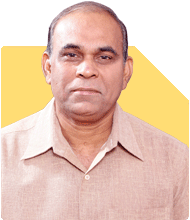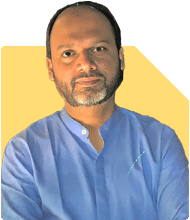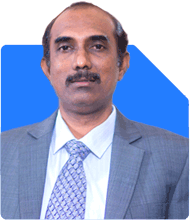
Dear Mr. Ramalingam,
Have been following your recommendations to many problems in rediff.
Greetings to you and team.
Request your guidance and support on my below condition.
# 46 years, Male, married wih no kids; Wife 43 years, both moms ~73, both dads ~77/80 years. | Retiring in 1 month because of unfortunate medical condition; No income from now - from me or any family member from now on; Fighting 4th stage cancer recent 6 months but managing fine so far | No need to take care of monthly expenses of both parents as they have sources for it (also 2 siblings of us will support them in future; they are well placed); Only for emergency medical, I will have to support.
# Financial goal is to manage expenses for myself (medical)/wife largely + for parents AND BEYOND THAT leave wealth for family (largely wife), if possible.
# Current value of investments:
(MFs 3.2Crs + All bank accounts 48L) + (EPFO 41L + SBI PPF 22L) + (Land 140L?, Home/flat 40L?) =
[Total 3.7Crs relatively liquid] + [EPFO+PPF 0.63 Crs] + [Assets: 1.4Crs*? + 40L*?]
Plan to withdraw EPFO/PPF sooner within a year and reinvest in MFs (beyond certain buffer I wish to keep in my bank account - as emergency fund + to balance any additional expenses w/o disturbing MF SWP, basically buffer during non-performing times of market).
^ MFs largely in equity | Mix of different type of funds: Large Cap (10%), Mid cap (7.5%), Small cap (10%), Multi cap (2.5%), Large+Mid (5%).... Flexi cap (12.5%), Multi asset (5%), Dividend yield (5%), Aggressive hybrid/equity n debt fund (5%), Dynamic asset allocation/Balanced advantage (5%).... Sectoral/thematic across Pharma n health care/Infra/Banking n finance/Transportation n Logistics/Services/Digital (30%)
# Monthly expenses: TOTAL Rs.1.5L from next month; Split of monthly will be Medical - Rs.1.05L, Home expenses includes all possible yearly too - Rs.30k, Misc - Rs.15k
# Specific financial questions:
1) With the above current monthly expenses planned to be managed through SWP (and/or dividend plans, mostly largely SEP plus bit of dividend plan in the mix) AND considering the inflation for expenses and growth of funds beyond monthly SWPs, how many years will my funds of say 4.33Crs last? 20 years or 25 years?.... For the purpose of this calculation, you can assume my monthly medical expenses (70% of my total) to exist for long, irrespective of my life expectancy (anyways this would be tight pessimistic scenario finance-wise).
2) Any larger suggestions on the mix of mutual funds? (Still want it to be aggressive)
3) Views on managing monthly expenses through SWP or Dividend plan or both?
4) Any other suggestions?
# Next steps:
1) Depending upon the answer for my first question, I need to see whether I need to sell my assets (land, home)? If so, will plan for it at some relevant point of time.
Ans: You have handled your financial life with great discipline and maturity, even during such a difficult personal phase. The clarity in your thoughts, documentation, and priorities shows a very strong and sensible financial mind. Your readiness to plan even now with balance and purpose is truly inspiring.
You have already achieved financial stability with almost Rs 4.33 crore of liquid and semi-liquid assets, plus additional property assets. Now the main objective is to secure sustainable monthly cash flow, ensure comfort for you and your wife, and preserve wealth for her future with minimal stress.
» Assessing Current Financial Position
You have Rs 3.2 crore in mutual funds, Rs 48 lakh in bank accounts, Rs 41 lakh in EPFO, Rs 22 lakh in PPF, a land worth around Rs 1.4 crore, and a home valued at Rs 40 lakh. Your total liquid and semi-liquid wealth is roughly Rs 4.33 crore, while total wealth including real estate is around Rs 6 crore.
You will retire in one month and will not have any regular income. Your total monthly expense will be around Rs 1.5 lakh, which includes Rs 1.05 lakh towards medical, Rs 30,000 towards household, and Rs 15,000 towards other needs. This means your annual expense will be Rs 18 lakh approximately.
Your parents are financially independent and have other siblings to support them. So your main responsibility is your own and your wife’s expenses, and occasional emergency support for parents.
This clarity helps in framing your future allocation and strategy with precision.
» Understanding Longevity of Your Funds
You have Rs 4.33 crore available to generate monthly income through mutual fund SWP or partial dividend route. With a balanced and active management, this corpus can last for 20 to 25 years or even beyond.
If we assume average post-tax growth from your mutual funds and rebalanced portfolio of around 8% to 9% per year, and your annual expense rising at 5% inflation, your corpus should comfortably sustain around 22 to 24 years.
This is a realistic assumption keeping your present asset mix and moderate withdrawals in mind. Your medical cost is the major component, and since you have planned for that conservatively, your fund durability is strong.
Even in a slightly lower growth period, say around 6.5% to 7%, your corpus should still support you and your wife comfortably for around 18 to 20 years, especially if you keep a buffer in your savings account as you planned.
So overall, the funds can last approximately 20–25 years without the need to sell your land or home in the short term.
» Evaluating Current Mutual Fund Portfolio Mix
Your present mutual fund allocation is diversified and slightly aggressive, which is good for long-term wealth retention. But it can be improved slightly to balance risk and liquidity.
At present you have about 60% in pure equity including large, mid, and small cap, 30% in sectoral funds, and the rest in hybrid and multi-asset categories. The overall equity exposure is on the higher side for someone who will depend fully on the portfolio for income.
Sectoral funds are volatile. While you may have gained in them earlier, they can fall sharply during market corrections. Keeping 30% in such thematic and sectoral funds is risky when you depend on regular withdrawals.
To make your portfolio more sustainable, shift around 10% to 15% from sectoral funds into diversified hybrid or balanced advantage funds. These funds adjust between equity and debt based on market cycles. They provide more stable monthly withdrawal potential.
Also, keep at least 15% in pure debt or short-duration mutual funds for regular SWP support. This portion can be drawn during poor market phases without disturbing your equity holdings.
Thus, an ideal mix for your current phase could be:
45–50% diversified equity (large, flexi, multi, and large-mid mix)
25–30% hybrid, balanced advantage, and multi-asset funds
15% pure debt or short-term bond funds
10% or less in selective sectoral or thematic funds, mainly healthcare since it is directly related to your expense area
This structure can balance growth, income, and capital safety effectively.
» On Aggressiveness and Stability
You have mentioned you still wish to stay aggressive. That mindset is understandable because growth helps maintain wealth longer. However, being fully aggressive when you rely on monthly withdrawals can cause stress in volatile markets.
A smart way to stay growth-oriented yet secure is to keep the core of your portfolio in stable diversified funds and maintain a smaller tactical allocation in sectoral or thematic ideas. This ensures your growth ambition remains, but downside risk is controlled.
You can continue annual review with a Certified Financial Planner for rebalancing and withdrawal adjustments. This disciplined approach helps extend the life of your corpus.
» EPFO and PPF Utilisation
Your EPFO and PPF amount together is around Rs 63 lakh. As you plan to withdraw them within a year, do so gradually based on your tax position. These funds are already in safe debt form. When reinvesting, allocate around half into debt mutual funds or balanced advantage funds. This ensures continuity of low volatility and better post-tax returns than keeping everything in fixed deposits.
The rest can be added to your equity allocation selectively for long-term stability. This gradual reinvestment plan is very practical and safe.
» Strategy for Monthly Expenses – SWP vs Dividend Plan
Between SWP and dividend options, SWP is clearly better. In SWP, you can control how much to withdraw and when. You also enjoy better tax efficiency since only the gains portion is taxed.
Dividend plans are irregular. Dividends depend on fund manager decisions and are fully taxable as income. You cannot rely on them for steady cash flow.
So maintain your regular monthly income through Systematic Withdrawal Plan (SWP). Keep a buffer of around 6–8 months of expenses in your bank account or liquid fund. Use that only if the market falls or SWP value drops temporarily.
This approach creates a self-managed income pipeline without touching your main principal for many years.
You can design your SWP in such a way that you draw monthly around Rs 1.5 lakh, and review every 6–9 months based on expenses and fund performance.
» Inflation Management and Growth Balance
Inflation is your main silent challenge. Medical costs can rise faster than normal inflation. So, you need your portfolio to grow at least 2–3% more than inflation.
That is why continuing partial exposure to equity and hybrid funds is essential. They provide real growth after inflation.
By withdrawing systematically and allowing the rest to compound, your portfolio will continue to grow and offset inflationary effects.
» Managing Emergency Medical and Unplanned Expenses
You can keep Rs 40–50 lakh in liquid form as a buffer. Around Rs 20–25 lakh can stay in high-quality liquid mutual funds, and another Rs 20–25 lakh in your bank or short-term deposits.
This ensures you can handle any sudden medical cost without disturbing your main investments or triggering large redemptions during a market correction.
You can also take a top-up health insurance policy if medically possible and if existing cover permits. This can reduce direct cash flow impact for major hospital bills.
» Tax Efficiency and Withdrawal Planning
Under current rules, equity mutual fund long-term capital gains above Rs 1.25 lakh are taxed at 12.5%. Short-term gains are taxed at 20%. For debt funds, both short and long-term gains are taxed as per your income tax slab.
Hence, SWP is tax-efficient because only the profit part in each withdrawal is taxed, not the full withdrawal amount. By staggering your withdrawals across years, you can stay under the lower LTCG tax bracket and avoid large one-time tax payments.
Also, choose regular mutual funds through a Certified Financial Planner and not direct funds. Direct funds appear cheaper but lack professional support and review. A qualified CFP ensures regular rebalancing, correct fund selection, and timely switches based on your unique situation.
» Estate and Legacy Planning
Since your wish is to leave wealth for your wife and possibly other family members, prepare a clear and valid will. Mention all your investments, bank accounts, mutual fund folios, and property details. Add proper nominations in each asset.
Also, consider creating a simple instruction note for your wife about how to operate the SWP, contact your Certified Financial Planner, and manage future withdrawals.
This will give her peace of mind and help her continue your financial discipline seamlessly.
» View on Selling Assets
You do not need to sell your land or house immediately. Your financial corpus is strong enough to last 20–25 years as discussed. Keep the land as a reserve. If, after 8–10 years, your medical cost rises or your corpus reduces significantly, you can then sell the land to add to the fund base.
Land is an illiquid asset, so it should be the last option to use, not the first. Till then, let it remain as a backup wealth or future inheritance for your wife.
» Emotional and Practical Comfort
You are already mentally strong and practical in your planning. Continue this same calm approach. Your financial independence is assured for many years. Focus now on your health, comfort, and time with your family.
Even if your expenses rise slightly due to medical reasons, your portfolio can handle it through rebalancing. The key is regular review, maintaining liquidity, and adjusting SWP amounts carefully every year.
Your wife will also remain financially independent through your thoughtful preparation. This itself is a great gift to her and your extended family.
» Finally
You have already built a wise, balanced, and meaningful financial setup. Your funds of around Rs 4.33 crore can comfortably sustain for 20–25 years with systematic withdrawal and prudent review. You can stay moderately aggressive with diversified equity and hybrid mutual funds, while avoiding excessive sectoral concentration.
SWP remains the best method for monthly income, supported by a healthy emergency buffer in liquid form. Avoid dividend plans, and invest through a Certified Financial Planner to ensure periodic rebalancing and tax efficiency.
There is no urgent need to sell your land or home now. Keep them as your long-term backup and potential legacy assets.
Your current planning is already very well-thought-out. You only need to fine-tune it slightly for risk control and ensure smooth income flow.
Best Regards,
K. Ramalingam, MBA, CFP,
Chief Financial Planner,
www.holisticinvestment.in
https://www.youtube.com/@HolisticInvestment
























